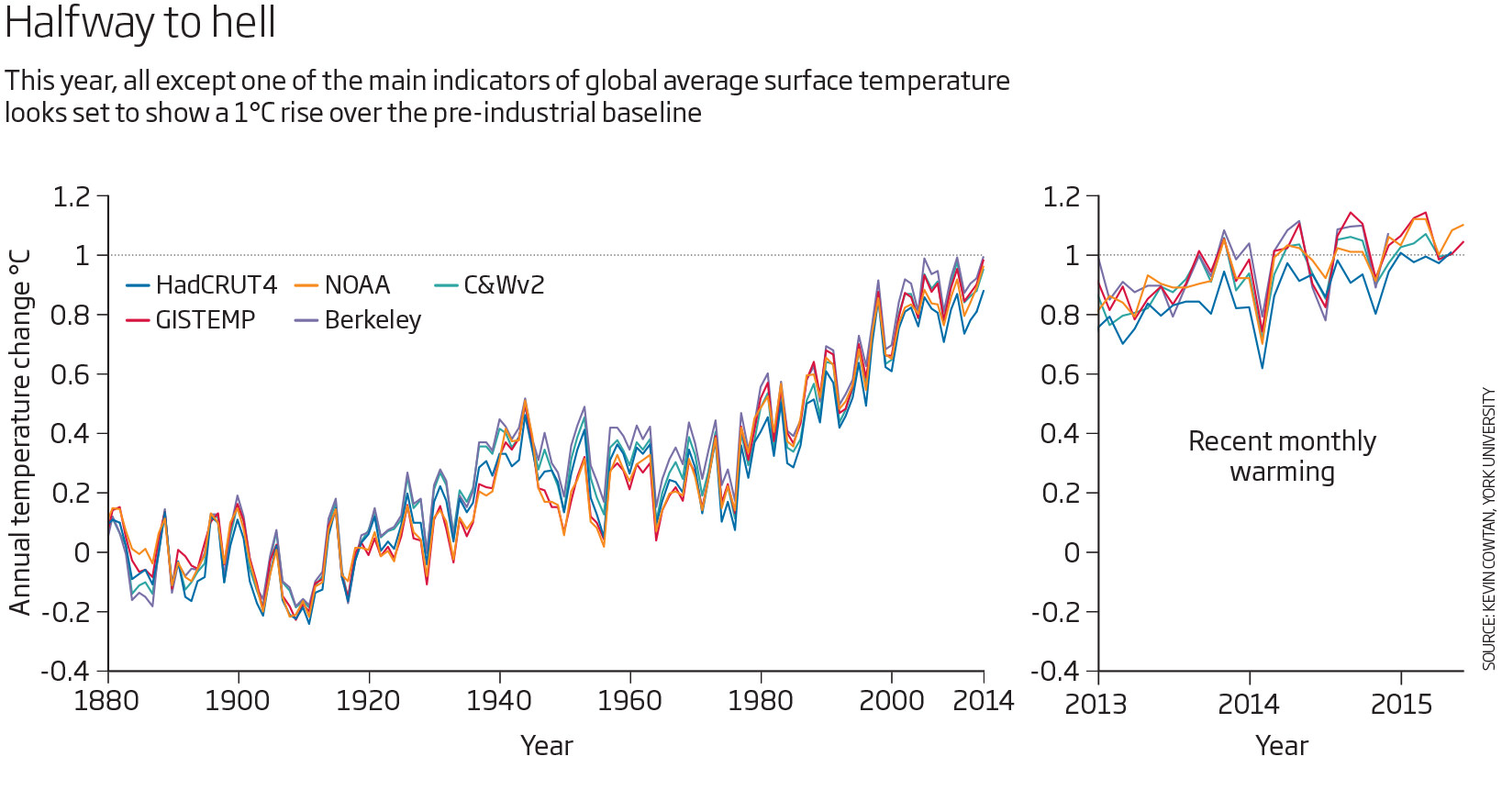Earth now halfway to UN global warming limit

2015 is shaping up to be a scorcher (Image: Mohammed Salem/Reuters)
IT’S the outcome the world wants to avoid, but we are already halfway there. All but one of the main trackers of global surface temperature are now passing more than 1 °C of warming relative to the second half of the 19th century, according to an exclusive analysis done for New Scientist.
We could also be seeing the end of the much-discussed slowdown in surface warming since 1998, meaning this is just the start of a period of rapid warming. “There’s a good chance the hiatus is over,” says Kevin Trenberth of the National Center for Atmospheric Research in Boulder, Colorado.
“The slowdown in warming since 1998 was partly due to oceans taking up more heat. That could be over”
Last year was the hottest since records began, but only just. With an El Niño now under way – meaning warm surface waters in the Pacific are releasing heat into the atmosphere – and predicted to intensify, it looks as if the global average surface temperature could jump by around 0.1 °C in just one year. “2015 is shaping up to smash the old record,” says Trenberth.
The UN negotiations on climate change aim to limit warming to 2 °C above pre-industrial temperatures. There is, however, no agreement on how to define pre-industrial temperature, says Ed Hawkins of the University of Reading, UK.
Because some global temperature records only begin in 1880, the period 1880 to 1899 is the easiest “pre-industrial” baseline for measuring warming. It is somewhat misleading, though, because the 1880s were particularly cold after the eruption of the Krakatoa volcano. The period 1850 to 1899 is a better baseline, says Hawkins.
What’s more, there are several long-term records of global annual average surface temperatures. All differ slightlybecause they use slightly different data sets and have their own ways of adjusting for relocations of weather stations and changes in instrumentation over time.
Kevin Cowtan of the University of York, UK, created and still maintains one such record, called “Cowtan & Way version 2.0″. It is based on another record, maintained by the UK Met Office, called HadCRUT4. Cowtan’s version differs because it compensates for missing data from areas with few weather stations, like the Arctic.
The various records also show temperature changes relative to different baselines. For instance, NASA’s GISTEMP record shows warming relative to the 1951 to 1980 average.
At the request of New Scientist, Cowtan adjusted his and other measures to show annual warming relative to the same time frame: the 1850 to 1899 period. All but one set of adjusted figures show that we will have already passed 1 °C before the next round of UN talks on a global climate treaty get under way in December (see graph).

“It looks very likely that all except HadCRUT4 will break 1 °C this year,” says Cowtan. “HadCRUT4 is somewhat dependent on a strong El Niño boost.”
And if climate talks do not lead to drastic action, we could pass the 2 °C mark around the middle of the century. The planet may continue to warm fast in the coming years, at a rate more like those from 1984 to 1998, when it warmed at 0.26 °C per decade.
From 1998 to 2012, the rate slowed to about 0.04 °C per decade, according to the last International Panel on Climate Change report. This was due to a combination of factors: a less active sun, higher levels of cooling aerosols from volcanoes and Asian factories, and increased heat uptake by the oceans.
One reason the oceans took up more heat was because of a phenomenon known as the Pacific Decadal Oscillation. The surface of the northern Pacific tends to flip between being extra cold and extra hot every two or three decades. It was in a cold, negative phase but now appears to have switched to a positive one, Trenberth says.
So temperatures might briefly drop next year after the current El Niño ends, he says, but the average warming rate over the next decade or so could be closer to the 0.2 °C per decade predicted for the business-as-usual pathway we are on.
We are also on the cusp of another ominous milestone: the level of carbon dioxide in the atmosphere is starting to edge past 400 parts per million. And with global emissions of greenhouse gases rising ever faster, there’s no end in sight to the grim trend.
This article appeared in print under the headline “Earth now halfway to warming limit”
Comments